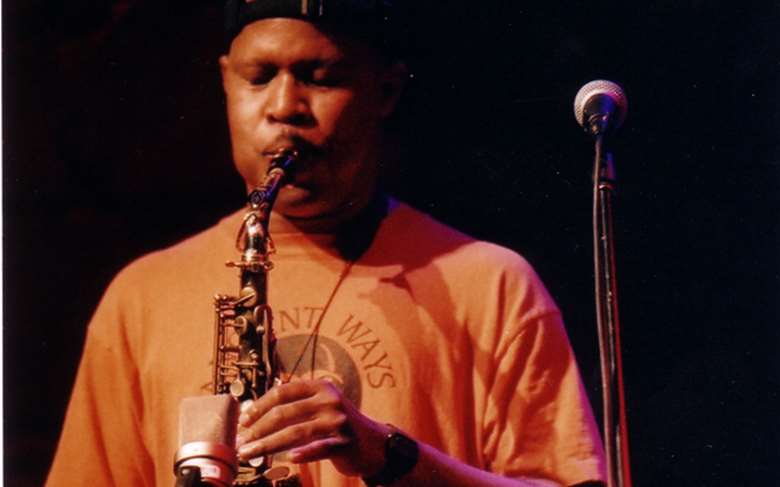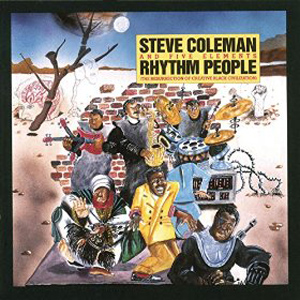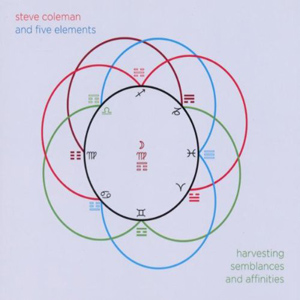Steve Coleman – Body of Elements
Thursday, January 7, 2016
Rhythm has always underscored saxophonist Steve Coleman’s 30-year recording career.

Across some 27 albums as a leader, he’s exerted a vortex-like pull of ancient and modern sounds, blending deep African and Asian rhythms with biting street funk and angular jazz harmony, forging a sound that’s made him one of the most original and influential musicians of his generation. With the release of his expansive album Synovial Joints, which draws on the interlocking pulses of the human body for inspiration, Coleman tells Kevin Le Gendre how much of this music emerged from the swirling grit of a blinding Ghanaian desert wind
From the mid-1950s, American governments recognised the role jazz artists could play as cultural ambassadors by way of the landmark State Department tours undertaken by Duke, Dizzy and ‘Pops’ in Africa, Asia and the Middle East. These icons visited Togo, Pakistan and Egypt, playing with locals and often providing the kind of souvenir portrait, none more exotic than that of Louis Armstrong on a camel with his horn tilted against the triangular backdrop of the pyramids, that would have puffed up the smart suits of the US diplomatic corps.
Some four decades later Steve Coleman made a vaguely similar journey but with far less regimentation. In 1993 the alto saxophonist traveled to Yendi in Ghana, West Africa entirely under his own steam, the corollary of which involved him hiring and driving a vehicle and negotiating the testing aftermath of a collision with an animal that had paws rather than humps. But his motivation was undimmed, his agenda precise. “I wanted to go to this very particular village because there was a guy who got up every morning and would beat on these two big drums and beat out the story of the tribe, the lineage of the kings and all this kind of stuff, without singing, just in drums. So I had to see this and know how it worked,” Coleman tells me on the phone from his home in Allentown, Pennsylvania.
“I was fascinated by it from reading about it and I went there specifically for that reason; to find out the musical mechanics. I’d always heard about ‘talking drums’ all my life but I wanted to know literally how it worked. So I went all the way there just to go to this particular village, I wanted to see it and feel it for myself. And then I wanted to talk to the elders in the village and interview them.”
“I wanted to see how it was possible for somebody to tell a story without words, with just sound and rhythms… how can you use these sonic shapes and tell a story?”
Musician as investigator-explorer is by no means a new phenomenon, and Coleman would be the first to acknowledge the research of many of his forebears, above all those he claims as sources of inspiration, but the anecdote is telling for a number of reasons. The Ghana excursion effectively opened up “a whole new world” for Coleman. He has since committed himself to at least one ‘study trip’ a year, the primary destinations thus far having been India, Indonesia, Brazil and Cuba. Added to this quest for information en situ is a seemingly unquenchable thirst for knowledge that can be sourced in the calmer environs of a library or bookshop, settings in which Coleman has spent many sabbaticals, expanding his mind with a variety of tomes that include anything from biographies on 16th Century European classical composers to Chancellor Williams’ The Destruction Of Black Civilization, a thought-provoking account of the hidden history of African culture.
 One can see a slanted reference to that work in the name of Coleman’s 1990 recording Rhythm People (The Resurrection Of Creative Black Civilization), and in many ways all of the epithets used in that title are very much key words that illuminate a body of work that now stretches to 27 releases. Rhythm, set in intricate matrices beyond the standard organisation of a pulse into downbeats and upbeats in clearly drawn measures, is a cornerstone of Coleman’s grand sonic edifice but the influence of civilizations, particularly ancient ones, as well as ritual and mythology, has also been crucial. As is the input of non-western culture. The superb 1996 album The Sign And The Seal, recorded in Cuba with Coleman’s group The Mystic Rhythm Society in collaboration with the entrancing folkloric drummers AfroCuba De Matanzas, remains one of the most fulfilled expressions of the leader’s desire to engage with a complex, ages-old belief system, in this case Santeria, and distils its very essence into intensely rich original music.
One can see a slanted reference to that work in the name of Coleman’s 1990 recording Rhythm People (The Resurrection Of Creative Black Civilization), and in many ways all of the epithets used in that title are very much key words that illuminate a body of work that now stretches to 27 releases. Rhythm, set in intricate matrices beyond the standard organisation of a pulse into downbeats and upbeats in clearly drawn measures, is a cornerstone of Coleman’s grand sonic edifice but the influence of civilizations, particularly ancient ones, as well as ritual and mythology, has also been crucial. As is the input of non-western culture. The superb 1996 album The Sign And The Seal, recorded in Cuba with Coleman’s group The Mystic Rhythm Society in collaboration with the entrancing folkloric drummers AfroCuba De Matanzas, remains one of the most fulfilled expressions of the leader’s desire to engage with a complex, ages-old belief system, in this case Santeria, and distils its very essence into intensely rich original music.
 Although synonymous with the term M-BASE (Macro-Basic Array of Structured Extemporisation), which he coined in the early 1980s, the 58 year-old Chicagoan, who impressed through his work with the Thad Jones-Mel Lewis Big Band after moving to New York in the late 1970s, has always aspired to being more than an exponent of fluidly uneven time signatures that nonetheless had the kind of taut, sharp, locked-down funkiness of a musician who greatly defined his youth, James Brown. Later recordings such as 2004’s Lucidarium and 2010’s Harvesting Semblances And Affinities, revealed a desire to articulate metaphysical and philosophical musings through sound as much as to construct music in mathematically challenging permutations. Yet this mission reaches back to the early jam sessions Coleman attended in Chi-Town.
Although synonymous with the term M-BASE (Macro-Basic Array of Structured Extemporisation), which he coined in the early 1980s, the 58 year-old Chicagoan, who impressed through his work with the Thad Jones-Mel Lewis Big Band after moving to New York in the late 1970s, has always aspired to being more than an exponent of fluidly uneven time signatures that nonetheless had the kind of taut, sharp, locked-down funkiness of a musician who greatly defined his youth, James Brown. Later recordings such as 2004’s Lucidarium and 2010’s Harvesting Semblances And Affinities, revealed a desire to articulate metaphysical and philosophical musings through sound as much as to construct music in mathematically challenging permutations. Yet this mission reaches back to the early jam sessions Coleman attended in Chi-Town.
“When I was younger I would get up and play,” the saxophonist recalls. “And some old guy would be saying ‘tell your story, young man’ and I always wondered what are they talking about. What story can you tell with music that doesn’t have words? I used to always wonder that when I was younger and all of this is connected because that’s what drove me to Ghana. I wanted to see how it was possible for somebody to tell a story without words, with just sound and rhythms and pitches and tonality and whatever your using. How can you use these sonic shapes and tell a story? Can somebody else understand?”
One might say that the subject matters Coleman has chosen to broach lie at the more esoteric end of human discourse. If his 1997 2CD-set Genesis & The Opening Of The Way saw him meditate on “the symbolic meaning of the seven days of creation” and “the concept of growth and regeneration” then his new work, Synovial Joints, has a biological rather than theological magnitude by way of composition inspired by the functions and rhythms of the human body. Sounds are based on the spring of limb, shift of fluid or rise and fall of breath. Flesh and blood are both score and orchestra. Some 21 musicians are deployed to achieve these ends as Coleman augments his longstanding Five Elements ensemble with horns, strings and percussion, and the results add more density to the leader’s patented vocabulary. Rhythm, melody and harmony tightly entwine like threads in a fabric, the specific lines coming together in a kind of warp and weft that shifts its centre in subtle ways. Internal tensions evolve as much as they do resolve.
As important as the overarching theme of anatomy is on Synovial Joints the album has other pieces that also draw on what has been a recurrent strand of Coleman’s work: nature. Clouds, water, earth, air and fire have all been the subject of previous compositions and the piece on the new set that reinforces the pattern is ‘Harmattan’. It is a wind that Coleman experienced in Ghana, a relentless blanketing of the air with fine dust that seems to get under as well as on top of the skin.
His experience of it dates back more than 20 years but the memory burned into his psyche, and its translation into music is fascinating. “It’s like it just engulfs everything,” Coleman explains. “This whole thing was like this grainy net that was constantly shifting shape and it was just throughout the whole air. Because of the wind it was constantly changing shape and I wanted to get that kind of shape-shifting feel, the grainy feel, all of that kind of stuff so the orchestration had that kind of thing… sometimes somebody would be walking towards you and it’s almost like they would come out of the dust. Their form would be like vague and as they came closer to you they become clearer. I tried to get that feel with some of the melodies, like they would rise up out of the net then fall back into it.
“The drums, bass and guitar… it’s like a puzzle in terms of the way they’re put together”
“I created this melody on my saxophone, just from the sensation that I had… with the other things that you put with the melody it becomes how to enhance that feeling. That’s where the orchestration comes in. It’s like making a sketch, then colouring it. You’re trying to select things in terms of which instruments play what to intensify the feeling.
“The drums, bass and guitar… it’s like a puzzle in terms of the way they’re put together. If you listen to any one by themselves there’s a lot of space in the part. But the way they’re put together it’s sort of like the fingers of your two hands interlocking if you folded your hands together. There’s this kind of interlocking puzzle effect, which is in African music in general, but
I wanted the rhythm to be like a really fine net of interlocking pieces that go on over this kind of long cycle.
“And the interlocking pieces that I used were heartbeats, just like if you touched your toes and you have a doum doum, like a heartbeat.” Coleman elaborates, his speech steady. “The overall mosaic or weaving you could say doesn’t sound like a heartbeat, just this driving rhythm. For me the individual heartbeats represented like individual particles that are interwoven in a certain way to form a fine kind of net because that was the feeling I got with the Harmattan.”
As Coleman stated, part of the conceptual base of his work can be traced to African music, to the complex percussion orchestration in which multiple drum figures are carefully arranged to create a single powerful sensation. With that in mind it’s also easy to see why the saxophonist would have been fascinated by the workings of the bata ensembles he found in Cuba, where the three members of the family of cone-shaped drums, the iya, itotele and onkokolo, cannot be separated.
Each is inextricably linked to the other, and although Coleman’s identity as a soloist is emphatically strong, above all the phrasing that potently blends drilled, snare-like staccato and fluttering, cymbal-like allegro lines, his music is decisively guided by the principle that the whole is greater than the sum of the parts. In that respect he upholds the legacy of Thelonious Monk, one of the ultimate exponents of an ‘all sounds into one’ musical philosophy, as he does that of any other artist from the improvising tradition. One thing that jumps out from a dialogue with Coleman is the enormous breadth of his artistic and intellectual references. By his own admission he is now less attuned to pop culture than in his formative years but that does not stop him professing admiration for blues behemoth Muddy Waters, or recalling his jams with Junior Wells and Buddy Guy at Chicago’s Checkerboard Lounge, or evoking long conversations with James Brown’s alto maestro Maceo Parker, or terming the Godfather’s music a “major innovation”. Or saying that he once went through what he calls “a Prince period”.
By the same token Coleman can name the latest reading material recommended to him by Sonny Rollins, for whom he has enormous reverence, or quote music theory expounded by the ancient Greeks.
 Above all there is a deep respect shown towards his predecessors, particularly those who have perhaps been marginalised by the jazz establishment. No greater manifestation of Coleman’s desire to bring such figures into the spotlight was his role as producer of fine albums by Sam Rivers and Bunky Green, when he was contracted to BMG and Label Bleu respectively, and exerted some influence on their A&R policy.
Above all there is a deep respect shown towards his predecessors, particularly those who have perhaps been marginalised by the jazz establishment. No greater manifestation of Coleman’s desire to bring such figures into the spotlight was his role as producer of fine albums by Sam Rivers and Bunky Green, when he was contracted to BMG and Label Bleu respectively, and exerted some influence on their A&R policy.
Then again it takes little prompting for him to explain a passion for the music of the elders. His own learning process is at stake. “Duke Ellington's finest year, he did these Sacred Concerts at the end of the 1960s, and I studied that because I wanted to know… not because I was religious necessarily, he was, and I wanted to find out why this music for this impulse, that feeling,” Coleman notes. “Then I would contrast that with something like A Love Supreme, which was also, you could say, very spiritual in its genesis. The music was very, very different because John Coltrane – Giant Steps was very different to Duke, but I still wanted to know what was the connection. What was the connection between Duke’s spiritual feeling and the music he produced and Coltrane’s spiritual feeling and the music he produced? And Yusef Lateef’s spiritual feeling and whoever. I wanted to know, just as a music student, specifically what devices they used, what approach did they take, all these questions you’re asking me. And then Béla Bartók, for example, was fascinated with nature and got a lot of inspiration from nature. Well, how? How exactly did he do that? Beethoven was very spiritual. How? How did that manifest itself in the music, and what are the mechanics behind how he did that? In essence the same reason I went to Ghana is the same thing I’m looking for in these people. I wanna know.”
This chimes with an earlier statement Coleman made. “Music is not an agreed-upon language… it’s a magic thing. If I play a note… what does that mean to people? There’s other things that have to come into play, those are all the reasons why I went to India and Ghana and all these places where people are playing music that is attached to meaning.”
Now, some 30 years into his career, Coleman appears to have lost none of his desire to broach the eternal mystery of sound. The stature that he already had as the leader who gave important early sideman gigs to some of the notable progressives in jazz in the past 20 years – think Robert Mitchell, Craig Taborn and Vijay Iyer in terms of pianists alone – was recently consolidated by the receipt of three major accolades: a Guggenheim Fellowship, a Doris Duke Artist Award and a MacArthur Foundation ‘genius grant’. But the saxophonist is keen to state that his core motivation remains exactly the same. “There’s no award in the world that’s ever written any music,” Coleman argues. “It all comes from inside you. It doesn’t change the music at all, not one bit. You still have to work just as hard as if you had nothing. It doesn’t change anything musically. You just keep doing what you’re doing. I don’t try to think about anything else but that.”
This article originally appeared in the June 2015 issue of Jazzwise. To find out how to subscribe to Jazzwise, visit: www.jazzwisemagazine.com/subscribe-to-jazzwise-magazine
Discover...
Feature John Coltrane – Giant Steps